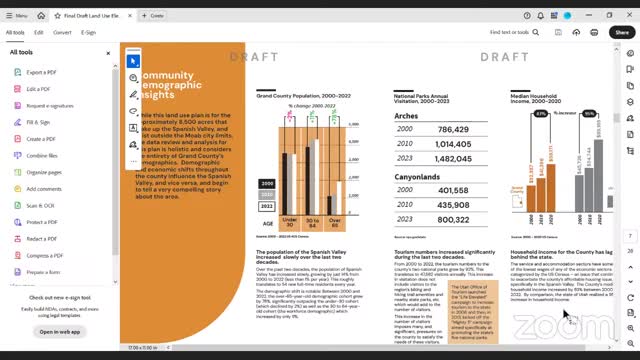Spanish Valley plans bold growth amid housing challenges
November 19, 2024 | Grand County Boards and Commissions, Grand County, Utah
This article was created by AI summarizing key points discussed. AI makes mistakes, so for full details and context, please refer to the video of the full meeting. Please report any errors so we can fix them. Report an error »

During a recent government meeting, officials discussed significant demographic shifts and economic trends impacting the region, particularly the increasing population of older residents and a surge in tourism. Data presented highlighted a notable rise in vacant housing, primarily attributed to second homes and nightly rentals, raising concerns about housing availability for local residents.
The meeting emphasized the importance of understanding the local housing market, with officials collaborating with the planning commission to differentiate between types of vacant housing. The discussion also touched on the robust growth of service-related jobs, which contrasts with declines in other economic sectors, underscoring the need for economic diversification strategies.
A proposed growth framework was introduced, focusing on land use planning principles aimed at fostering development in designated centers while preserving the character of the Spanish Valley. Officials outlined plans for two regional centers and two neighborhood centers, which are intended to promote mixed-use development and enhance walkability. These centers are strategically located to leverage existing infrastructure and provide essential services to residents.
The meeting also addressed the need to protect the edges of the community from overdevelopment, ensuring that growth is managed sustainably. Recommendations included a zoning code update and exploring public-private partnerships to incentivize development in targeted areas.
Collaboration with regional partners, including the city of Moab and the Utah Department of Transportation, was highlighted as crucial for aligning land use and transportation planning. Officials expressed interest in leveraging tourism revenue to address housing needs and enhance community services.
Overall, the meeting underscored the importance of strategic planning to accommodate growth while maintaining the unique character of the region, with a focus on sustainable development and community collaboration.
The meeting emphasized the importance of understanding the local housing market, with officials collaborating with the planning commission to differentiate between types of vacant housing. The discussion also touched on the robust growth of service-related jobs, which contrasts with declines in other economic sectors, underscoring the need for economic diversification strategies.
A proposed growth framework was introduced, focusing on land use planning principles aimed at fostering development in designated centers while preserving the character of the Spanish Valley. Officials outlined plans for two regional centers and two neighborhood centers, which are intended to promote mixed-use development and enhance walkability. These centers are strategically located to leverage existing infrastructure and provide essential services to residents.
The meeting also addressed the need to protect the edges of the community from overdevelopment, ensuring that growth is managed sustainably. Recommendations included a zoning code update and exploring public-private partnerships to incentivize development in targeted areas.
Collaboration with regional partners, including the city of Moab and the Utah Department of Transportation, was highlighted as crucial for aligning land use and transportation planning. Officials expressed interest in leveraging tourism revenue to address housing needs and enhance community services.
Overall, the meeting underscored the importance of strategic planning to accommodate growth while maintaining the unique character of the region, with a focus on sustainable development and community collaboration.
View full meeting
This article is based on a recent meeting—watch the full video and explore the complete transcript for deeper insights into the discussion.
View full meeting

